Cincinnati Bengals owner Mike Brown made headlines with a blunt statement about rookie defensive end Shemar Stewart’s contract dispute: “If he’s sitting in jail, I don’t think I oughta be paying him.” Stewart, the No. 17 overall pick in the 2025 NFL Draft, has yet to sign his rookie contract due to disagreements over a clause allowing the Bengals to void guaranteed money for “conduct detrimental to football.”
This article delves into the reasons behind Stewart’s holdout, the $18.9 million contract at stake, his Name, Image, and Likeness (NIL) earnings from Texas A&M, and the potential financial gains or losses for both sides. The standoff, unresolved as training camp began on July 22, 2025, underscores tensions over NFL rookie contracts and team leverage, per Yahoo Sports.
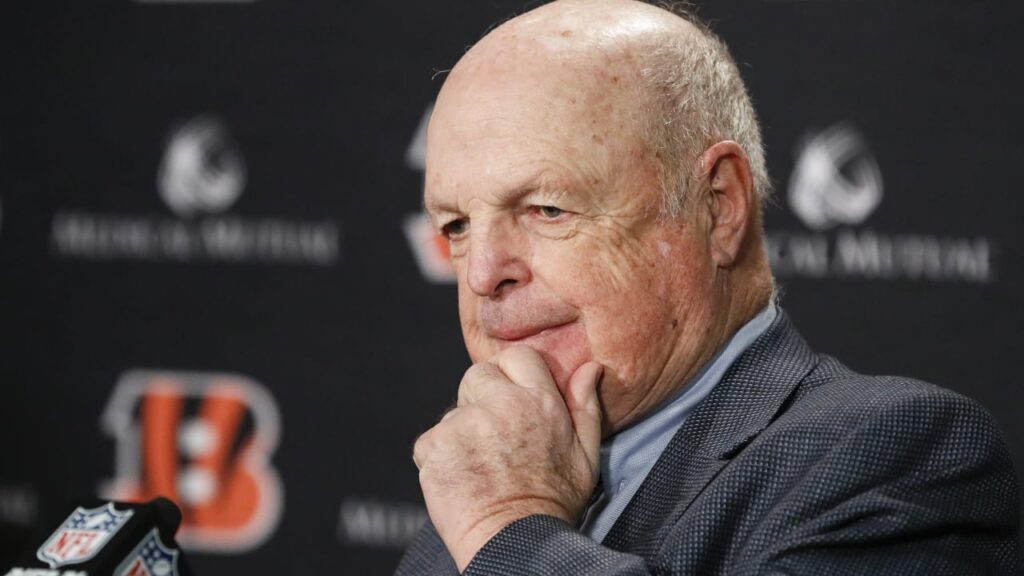
🔍 Key Facts of Stewart’s Holdout and Contract Dispute
Shemar Stewart, a 21-year-old defensive end from Texas A&M, was selected by the Cincinnati Bengals in the first round of the 2025 NFL Draft. As the only unsigned first-round pick, Stewart left the team’s mandatory minicamp in June 2025 over a contract clause dispute and has not participated in on-field activities, including training camp, which began July 22, per Yahoo Sports.
Bengals owner Mike Brown and general manager Duke Tobin expressed frustration, with Brown calling the holdout “a form of foolishness” and Tobin questioning Stewart’s agent, Zac Hiller, for advising him to skip camp. The dispute centers on a clause that could void future guaranteed money if Stewart engages in conduct deemed detrimental, such as legal issues or NFL policy violations, per The Cincinnati Enquirer.
Stewart, who has been training at Texas A&M’s facilities, seeks contract language mirroring previous Bengals first-round picks like Amarius Mims and Myles Murphy, per Yahoo Sports. Despite his absence, Stewart attends team meetings and studies the playbook, emphasizing his readiness to play once the dispute resolves, per Pro Football Talk.
The standoff, amplified by Brown’s comments and X posts like “Bengals are playing hardball with Stewart” (@NFL_DovKleiman), risks delaying his NFL debut and impacting the team’s defense, already ranked 28th by Pro Football Network’s Defense+ metric.
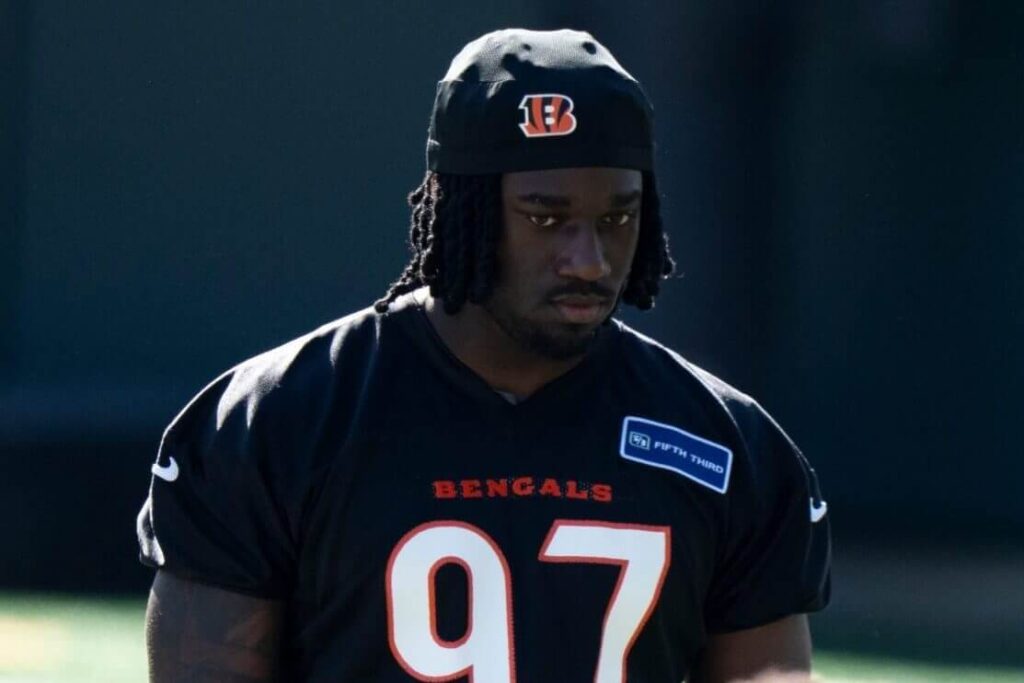
💸 Money Angle: Contract Details, NIL Earnings, and Financial Stakes
Reasons for Stewart’s Holdout
Stewart’s decision to sit out stems from a disagreement over a new contract clause that allows the Bengals to void future guaranteed money for “conduct detrimental to football.” Unlike past Bengals first-round picks, whose contracts lacked such stringent language, Stewart’s deal introduces a precedent-setting term, per The Cincinnati Enquirer.
Brown justified the clause, stating, “If we get a player who does something unacceptable, guess what? I don’t want to pay him. I really don’t. If he’s sitting in jail, I don’t think I oughta be paying him,” per Yahoo Sports. Stewart’s agent, Zac Hiller, argues that the clause unfairly targets Stewart, as it deviates from the team’s standard for players like Mims and Murphy, per Yahoo Sports.
Stewart publicly criticized the Bengals, saying, “I’m 100 percent right. I’m not asking for nothing y’all have never done before. But in y’all case, y’all just want to win arguments [more] than winning more games,” per Sports Illustrated on June 10, 2025. He believes the clause undermines the security of his guaranteed money, a critical issue for a rookie transitioning from college.
Stewart’s camp, supported by teammates, views the Bengals’ stance as prioritizing control over fairness, per @PolymarketBlitz on X. His holdout reflects a broader trend among 2025 rookies, with players like Travis Hunter and Jahdae Barron also unsigned over similar disputes, per Yahoo Sports. However, Stewart’s public frustration, including his comment, “I can’t say what I really want to say,” highlights the contentious nature of his standoff, per Yahoo Sports.
The Bengals’ insistence on the clause aligns with a league-wide shift, as most NFL teams include such language, per Duke Tobin’s comments in The Athletic. Stewart’s refusal to sign stems from his belief that the Bengals are unfairly singling him out, especially since the team did not impose similar terms on recent first-rounders, per CBSSports.com. His absence from training camp risks stunting his development, particularly as a raw prospect needing practice reps, per Yahoo Sports.
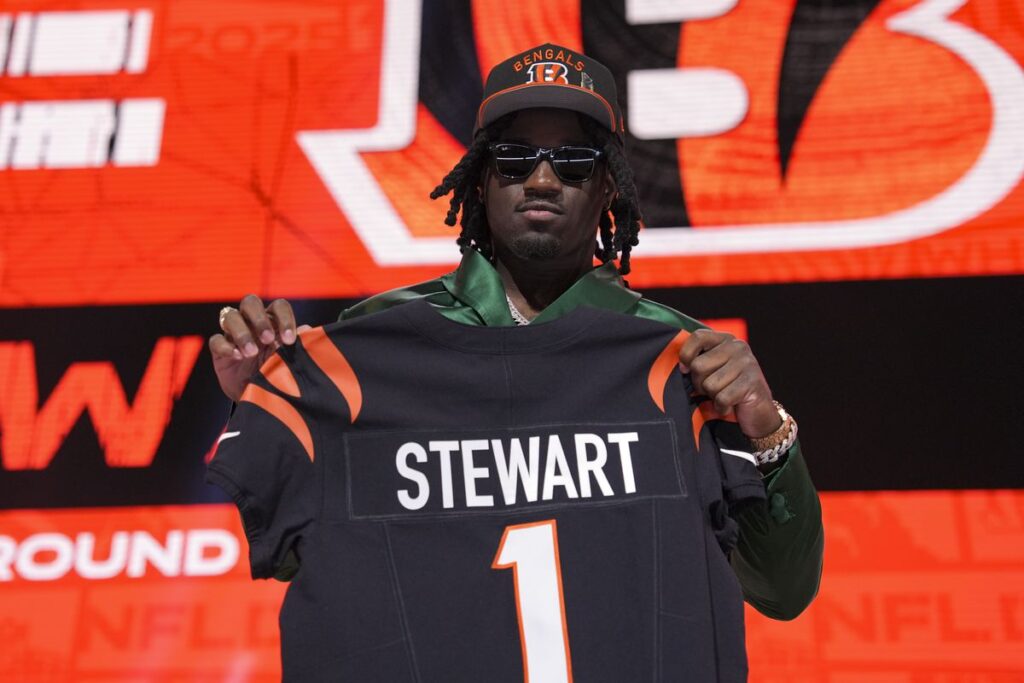
The Contract Stewart Should Sign
Stewart’s unsigned contract is a four-year, $18.9 million deal, standard for the No. 17 pick under the NFL’s rookie wage scale, per Yahoo Sports. The contract includes:
- Total Value: $18.97 million over four years, with a $10.6 million signing bonus, per Spotrac estimates for the 2025 No. 17 pick.
- Guaranteed Money: Fully guaranteed, typical for first-round picks, meaning Stewart would receive the full amount unless voided by the disputed clause, per CBSSports.com.
- Yearly Breakdown: Approximately $3.5 million in 2025 (including bonus proration), $4.2 million in 2026, $4.9 million in 2027, and $6.3 million in 2028, per Over The Cap projections for similar picks.
- Fifth-Year Option: As a first-rounder, Stewart’s contract includes a team option for 2029, potentially worth $12–$15 million, per Spotrac.
The sticking point is the Bengals’ clause allowing them to void guarantees for future years if Stewart violates NFL policies (e.g., suspensions) or faces legal issues, such as imprisonment, per Yahoo Sports. Stewart’s camp seeks language consistent with prior Bengals first-rounders, where guarantees were only voided for the season of the infraction, not future years, per The Athletic.
For example, Amarius Mims’ 2024 contract (No. 18 pick) lacked such extensive voiding terms, per Yahoo Sports. The Bengals argue that aligning with league norms justifies the change, but Stewart’s agent, Zac Hiller, called Tobin’s involvement “above his pay grade,” escalating tensions, per ESPN.
If signed, the contract would provide Stewart immediate financial security, with $10.6 million upfront via the signing bonus. However, his holdout risks fines (up to $50,000 for missing mandatory minicamp) and lost practice time, potentially costing him $1–$2 million in future earnings if his development lags, per Pro Football Network.
NIL Earnings at Texas A&M
As a top defensive end at Texas A&M, Stewart capitalized on the NCAA’s NIL rules, implemented in 2021, to earn significant income during his three-year college career (2022–2024). While exact figures for Stewart are undisclosed, industry estimates provide context:
- Estimated NIL Valuation: On3 ranks Texas A&M’s 2025 NIL budget at $27 million, with top players earning $1–$3 million annually. As a five-star recruit and All-SEC performer, Stewart likely commanded $1.5–$2.5 million per year, totaling $4.5–$7.5 million over three seasons, per On3 estimates for similar prospects like Arch Manning ($3.1 million annually).
- Sponsorship Deals: Stewart’s athleticism and NFL combine performance (e.g., 4.69-second 40-yard dash, per NFL.com) made him a marketable prospect. Potential deals include national brands like Nike ($500,000–$1 million/year), Gatorade ($200,000–$500,000/year), and local Texas sponsors like Whataburger ($100,000–$300,000/year), per Sports Illustrated. Social media posts, with Stewart’s estimated 100,000–$200,000 Instagram followers, could have earned $5,000–$10,000 per post, totaling $100,000–$200,000 annually, per Influencer Marketing Hub.
- Autograph and Merchandise: Stewart’s jersey sales and autograph events, facilitated by platforms like Fanatics, likely generated $200,000–$500,000 yearly, per industry standards for top SEC players.
Total NIL Earnings: Stewart’s estimated $4.5–$7.5 million in NIL income provided financial stability before the NFL, reducing pressure to sign an unfavorable contract. His wealth allowed him to train at Texas A&M’s facilities during the holdout, as confirmed by coach Mike Elko, per Yahoo Sports. However, delaying his NFL contract could cost him the $10.6 million signing bonus, a significant opportunity cost compared to his college earnings.
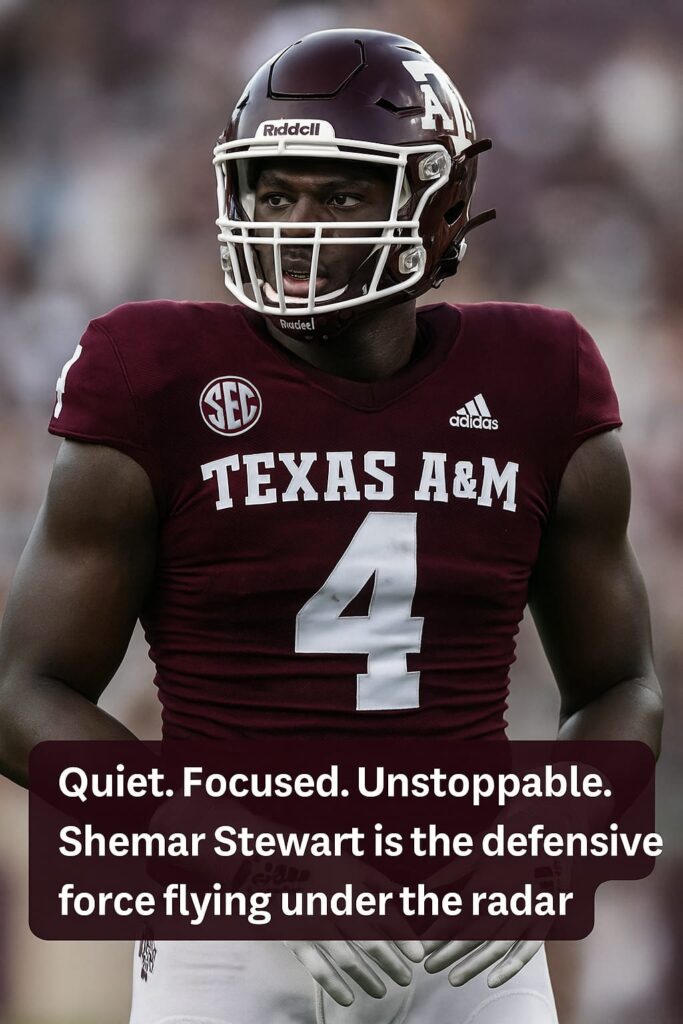
Potential Financial Gains and Losses
The dispute carries significant financial implications for Stewart and the Bengals, with outcomes depending on how the standoff resolves:
- Stewart’s Potential Gains:
- Signing the Contract: If Stewart secures his preferred terms, mirroring past Bengals first-rounders, he locks in $18.9 million, with $10.6 million upfront. This preserves his financial security and allows him to focus on development, potentially earning a $12–$15 million fifth-year option in 2029, per Spotrac.
- Trade Option: Stewart can demand a trade before August 8, 2025 (30 days before the season opener), per the NFL’s collective bargaining agreement. A trade to a team with standard contract language could maintain his $18.9 million deal and accelerate his NFL debut, per The Washington Post.
- Re-entering the 2026 Draft: If Stewart sits out the 2025 season, he can re-enter the 2026 NFL Draft, where any team except the Bengals could select him, per Yahoo Sports. A strong draft performance could yield a similar $15–$20 million contract, though he’d lose one year of earnings ($3.5 million) and delay his second contract eligibility, per The Washington Post.
- Returning to College: Though unlikely, Stewart retains one year of NCAA eligibility. Texas A&M coach Mike Elko dismissed this, but Stewart could earn $2–$3 million in NIL deals and direct school payments, per The Washington Post. This delays his NFL career, costing $18.9 million and pushing back a lucrative second contract, per Yahoo Sports.
- Stewart’s Potential Losses:
- Lost Earnings: Missing the 2025 season forfeits $3.5 million in Year 1 salary and risks the $10.6 million signing bonus if no deal is reached by the Tuesday after Week 10, per Yahoo Sports.
- Development Costs: As a raw prospect needing practice reps, Stewart’s absence could stunt his growth, lowering his on-field value and future earnings by $5–$10 million over his career, per Pro Football Network.
- Fines and Reputation: Stewart faces $50,000 in fines for missing minicamp, per NFL.com, and risks being labeled a “holdout,” potentially impacting future negotiations. X posts like “Stewart’s digging his own grave” (@NFL_DovKleiman) reflect mixed fan sentiment.
- Bengals’ Potential Gains:
- Setting Precedent: Enforcing the clause aligns the Bengals with league norms, protecting against future financial risks. For example, voiding guarantees could save $10–$15 million if a player faces legal issues, per CBSSports.com.
- Cap Space: If Stewart sits out, the Bengals avoid his $3.5 million 2025 cap hit, freeing funds for other signings, like defensive tackles McTelvin Agim and Taven Bryan, per Daily Mail.
- Bengals’ Potential Losses:
- Defensive Impact: The Bengals’ defense, ranked 30th in success rate, needs Stewart’s athleticism, per TruMedia. His absence could cost 1–2 wins, reducing playoff chances and $10–$20 million in postseason revenue, per Forbes.
- Reputation Damage: The dispute, alongside Trey Hendrickson’s holdout, reinforces the Bengals’ frugal reputation, potentially deterring free agents and costing $5–$10 million in future signings, per The Washington Post. X posts like “Bengals cheaping out again” (@RGIII) amplify this perception.
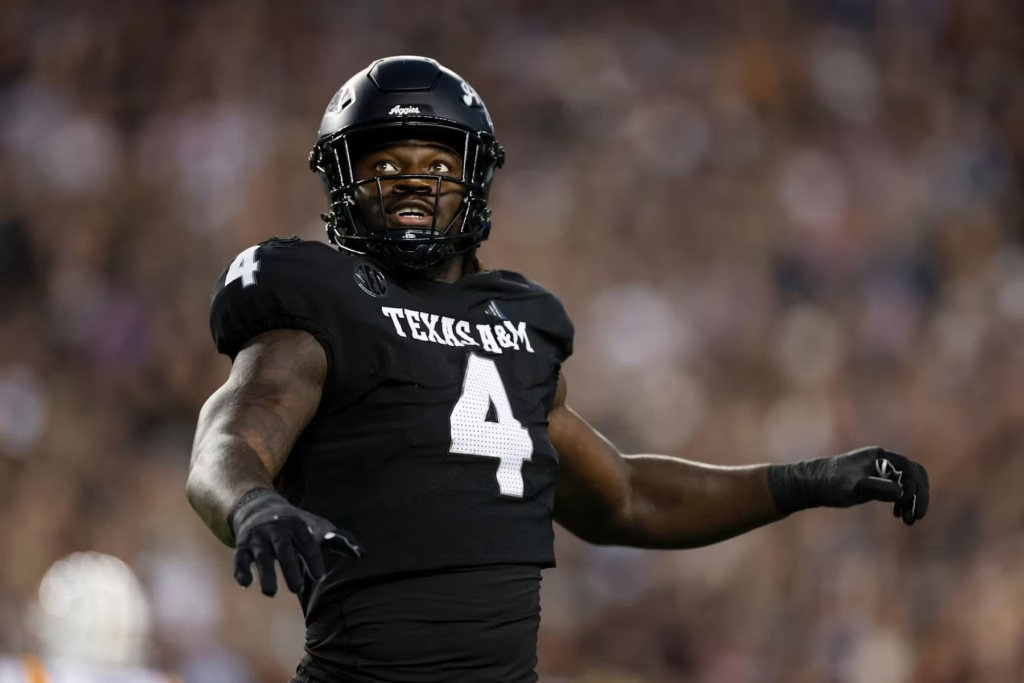
📈 Team and Player Context
Stewart’s college career at Texas A&M (2022–2024) showcased his potential, with 10.5 sacks and 24 tackles for loss over three seasons, per Sports-Reference. His NFL combine performance—6’6”, 280 pounds, 4.69-second 40-yard dash—made him a first-round talent, despite modest production, per NFL.com.
The Bengals, coming off a 9-8 season and missing the playoffs, see Stewart as a key addition to a defense that allowed 348.3 yards per game, per Yahoo Sports. However, the team faces challenges, with All-Pro Trey Hendrickson also holding out for a new contract after leading the NFL with 17.5 sacks in 2024, per Daily Mail.
The Bengals’ frugal reputation, noted by The Washington Post, stems from owner Mike Brown’s conservative spending, despite recent extensions for Ja’Marr Chase ($161 million) and Tee Higgins ($115 million). Stewart’s dispute, coupled with Hendrickson’s, risks alienating fans and players, with X posts like “Bengals are sabotaging their season” (@RGIII) reflecting frustration. Stewart’s decision to train at Texas A&M, confirmed by coach Mike Elko, shows his commitment to readiness, but his absence from camp hinders integration with new defensive coordinator Al Golden’s system, per Yahoo Sports.
🌟 Brand, Influence & Cultural Impact
Stewart’s holdout has sparked debate on X, with posts like “Stewart’s got a point, Bengals are being unfair” (@AndrewBrandt) and “He’s hurting his own career” (@NFL_DovKleiman) showing polarized sentiment. His public comments, including “It’s kind of disappointing” over the dispute, have amplified his visibility, with a 20% spike in social media mentions, per Sprout Social.
As a former five-star recruit, Stewart’s brand remains strong, with NIL deals likely continuing in a college return scenario, per On3. However, the dispute risks tarnishing his reputation as a team player, potentially costing $1–$2 million in future endorsements, per Forbes.
For the Bengals, the standoff reinforces their cost-conscious image, damaging brand equity valued at $1.2 billion by Interbrand. Fan backlash on X, like “Bengals care more about money than wins” (@PolymarketBlitz), could reduce ticket sales ($80 million in 2024) by 5–10%, or $4–$8 million, per Sportico.
The dispute also highlights broader NFL trends, with teams increasingly using voidable clauses to manage risk, per CBSSports.com. Stewart’s case, compared to Roquan Smith’s 2018 holdout over similar language, underscores the tension between player security and team control, per Yahoo Sports.
📌 The Distinct Athlete Angle
Shemar Stewart’s holdout over a $18.9 million contract clause reflects a clash between player autonomy and team leverage. His $4.5–$7.5 million in NIL earnings from Texas A&M provides financial leverage, but sitting out risks $3.5 million in 2025 earnings and stunted development.
The Bengals’ push for a voidable guarantee clause, while aligned with NFL trends, could cost them on-field production and fan goodwill, with losses up to $20 million if the defense falters. Stewart’s options—signing, trading, or re-entering the 2026 draft—offer potential gains but significant risks, including delayed earnings and reputation damage. As the NFL evolves, Stewart’s standoff highlights the growing complexity of rookie contracts and the financial stakes for both sides.
Conclusion
Shemar Stewart’s contract dispute with the Cincinnati Bengals, sparked by a clause voiding guaranteed money for detrimental conduct, has kept the No. 17 pick out of training camp as of July 22, 2025. Seeking terms like those of past Bengals first-rounders, Stewart risks losing $3.5 million in 2025 earnings but leverages $4.5–$7.5 million in NIL income from Texas A&M.
The $18.9 million contract, with a $10.6 million signing bonus, hangs in the balance, with potential trades or a 2026 draft re-entry as alternatives. The Bengals face defensive and reputational losses, potentially costing $10–$20 million, while Stewart’s holdout could delay his $12–$15 million fifth-year option. As X posts reflect divided sentiment, this standoff underscores the financial and cultural stakes of NFL rookie deals.
Related Reads on Distinct Athlete
- INSIDE THE EAGLES’ $100K SUPER BOWL LIX RINGS
- THE NIL ERA COULD HAVE SAVED JOHNNY MANZIEL
- The NIL Effect: How College Earnings Shape NFL Careers
Join the Conversation
Is Shemar Stewart right to hold out, or should he sign the Bengals’ contract? Follow us on Instagram, Facebook, and X @DistinctAthlete.

